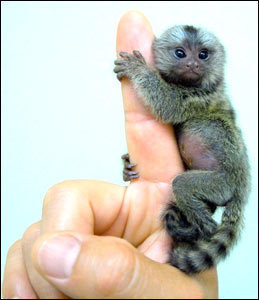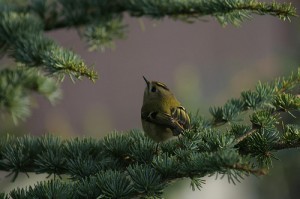Smallest Monkey
If asked to name the smallest monkey in the world, most would  probably answer the Philippine Tarsier. However, this assumption appears to be incorrect, as the tarsier’s true taxonomy is under dispute, and an apparently more qualified contender steps up to the plate.
probably answer the Philippine Tarsier. However, this assumption appears to be incorrect, as the tarsier’s true taxonomy is under dispute, and an apparently more qualified contender steps up to the plate.
Tarsius syrichta, the Philippine Tarsier, is located in the southeast part of the Philippine archipelago; namely, the islands of Bohol, Samar, Leyte, and Mindanao. It is noted for its unusual physical appearance, such as its round heads, big nearly-translucent ears, and its large eyes. As one would expect, the Tarsier’s uncommonly proportioned sense organs endow it with exceptional sight and hearing. The Tarsier also appears to have no neck, but is capable of rotating its head 180 degrees. This actually serves a purpose, as its eyes are set to its skull and are unable to move in their sockets.
Weighing 80-160 g (2.8-5.6 oz) and measuring approximately 85-160 mm (3.35-6.30 in), around the size of an adult human hand, the Tarsier is indeed one of the smallest primates in the world. However, it’s debatable whether or not it should be considered as the world’s smallest monkey. There are those who consider the creature to be part of the prosimians, which would include bushbabies and lemurs. On the other hand, some have observed that the Tarsier has certain phylogenetic characteristics in common with monkeys and apes. Some even suggest that it may belong to its own suborder separate from other primates.
A more rightful candidate for the title of world’s smallest monkey is Cebuella pygmaea, also known as the Pygmy Marmoset. It is endemic to the rainforests of South America, particularly western Brazil, northern Bolivia, southeastern Colombia, eastern Ecuador, and eastern Peru. Its distinctive physical traits include a yellowish-brown coat with speckles of gray, a soft mane around its head and its cheeks, and a ringed tail. Its 2 subspecies are Cebuella pygmaea pygmaea (Western Pygmy Marmoset) and Cebuella pygmaea niveiventris (Eatern Pygmy Marmoset)
The Pygmy Marmoset is of course named for its small size. It ranges in length from 14-16 cm (5.5-6.3 in), not including its tail which measures from 15-120 cm (5.9-7.9 in). The males of the species weigh about 140 g (4.9 oz), while females are lighter at 120 g (4.2 oz). Other names that likewise denote this creature’s petite size are the Dwarf Monkey, mono de bolsillo (which means “pocket monkey” in English) and leoncito (or “little lion”). In the wild, the Pygmy Marmoset is known to have a life span of 11-12 years. Interestingly, it can survive even longer in captivity, living well into their early 20’s.





